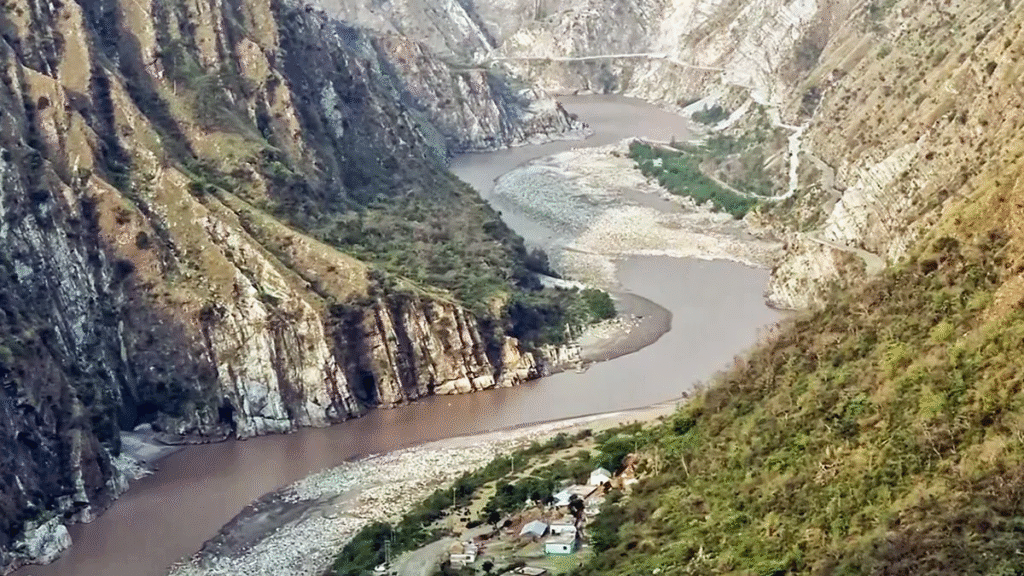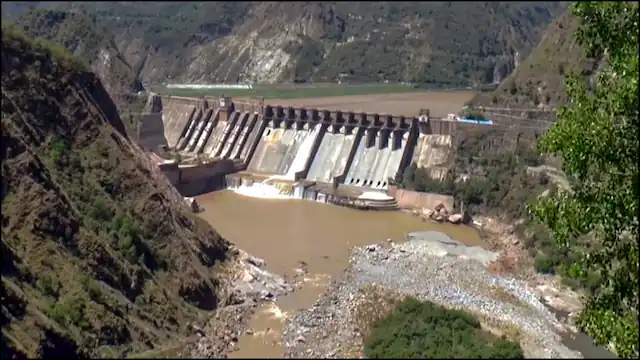
The recent satellite images capturing the flow and condition of the Chenab and Jhelum rivers have sent shockwaves across South Asia, particularly in Pakistan. Barely one month after India’s formal suspension of operations related to the Indus Waters Treaty (IWT), these images reveal a rapidly worsening water situation on the Pakistan side. The stark changes in river volumes and flow patterns underscore that Pakistan’s water security is under immense threat. This unfolding crisis, driven by geopolitical tensions, environmental stress, and climate change, demands urgent attention given its deep ramifications for millions who depend on these lifelines for agriculture, drinking water, and energy.
The Indus Waters Treaty: Cornerstone of Transboundary Water Management
To appreciate the severity of the current situation, it is essential to revisit the historical and geopolitical significance of the Indus Waters Treaty. Signed in 1960 under the mediation of the World Bank, the treaty was a landmark agreement between India and Pakistan designed to allocate the waters of the six rivers of the Indus basin in a manner that ensured both countries had reliable water access.
Under the treaty, India was granted control over the eastern rivers—the Ravi, Beas, and Sutlej—while Pakistan was allocated the western rivers—the Indus, Chenab, and Jhelum. This division was meant to provide Pakistan with sufficient water to sustain its agriculture and economy, even though most of the river sources lie in Indian territory.
The treaty stood out as a rare example of cooperation between two countries with a history of conflicts and wars. Despite periodic tensions and disputes, the IWT functioned effectively for decades, preventing water wars and fostering limited cooperation in data sharing and infrastructure.
However, in recent years, rising political tensions have strained this arrangement. The decision by India in May 2025 to suspend treaty-related operations marks a critical turning point. This move curtails Pakistan’s access and management over the waters of the western rivers, directly impacting the volume of water flowing downstream.
Satellite Imagery: Visual Evidence of a Deepening Crisis
A month after the treaty halt, satellite images have exposed the full scale of the water crisis. Compared with imagery from previous months and years, there is an unmistakable reduction in water flow in the Chenab and Jhelum rivers. Vast sections of the riverbeds are exposed, showing dried patches where water once flowed freely.
Experts attribute this drastic decline primarily to increased upstream regulation on the Indian side. These include intensified dam operations, withholding of water releases, and tighter controls on reservoirs. The changes are neither seasonal nor accidental but are linked to deliberate operational policies following the treaty suspension.
The visuals reflect a severe hydrological disruption with far-reaching consequences. Pakistan’s “throat drying up,” as described in media reports, is no exaggeration—it is a harsh reality threatening agriculture, human consumption, and energy production.
The Economic Toll: Agriculture and Industry Under Siege
Agriculture is the backbone of Pakistan’s economy, accounting for nearly 20% of the GDP and employing more than 40% of the workforce. The provinces of Punjab and Sindh rely heavily on irrigation from the Chenab and Jhelum rivers. The water deficit caused by reduced river flows is already impacting sowing seasons, crop yields, and food security.
Farmers report fields turning barren, with water scarcity forcing many to abandon traditional crops like wheat, sugarcane, and rice, which require substantial water input. This leads to not only reduced agricultural output but also loss of income for rural households dependent on farming.
The decline in agriculture ripples through the entire economy. Reduced crop production leads to lower exports of agricultural products, impacting foreign exchange earnings. Food inflation is likely to rise, increasing hardship for urban and rural consumers alike.
Beyond agriculture, industries dependent on water for manufacturing, processing, and cooling are affected, risking slowdown and job losses. The combined stress on rural livelihoods and industrial output threatens Pakistan’s fragile economic recovery.
Hydroelectric Power Generation and Energy Crisis
Pakistan’s energy sector is intricately linked to water availability, with hydroelectric power constituting about 30% of the national electricity mix. The Jhelum and Chenab rivers host several hydroelectric projects critical to meeting Pakistan’s energy needs.
The declining flow reduces water available for these plants, leading to lower power generation. This energy shortfall increases dependence on thermal power stations running on imported fossil fuels such as coal and oil, which are costlier and environmentally damaging.
Consequently, Pakistan faces not only an electricity deficit but also higher import bills and worsening air pollution. Power outages and load-shedding disrupt daily life and industrial productivity, compounding economic challenges.
Environmental and Social Ramifications
Beyond economic metrics, the water crisis profoundly affects the environment and social fabric of the region. The Chenab and Jhelum rivers support rich biodiversity, including numerous fish species and riparian ecosystems that sustain livelihoods.
As water levels drop, aquatic habitats shrink and water quality deteriorates. Pollutants become more concentrated, endangering aquatic life and the health of communities relying on river water.
Socially, water scarcity exacerbates inequalities. Marginalized communities, small farmers, and rural households bear the brunt of shortages. Competition over limited water resources can trigger local conflicts and heighten social tensions.
In urban areas, shortages of clean drinking water can lead to public health crises. Water-borne diseases often spike during shortages, straining healthcare systems.
Geopolitical Tensions and Diplomatic Impasse

The suspension of the Indus Waters Treaty by India escalates long-standing geopolitical tensions. Pakistan’s government and officials have condemned the move as a violation of international agreements and a deliberate act to undermine its sovereignty and development.
Pakistan has sought diplomatic channels, international mediation, and legal recourse to challenge India’s suspension. However, bilateral relations remain strained, with little indication of immediate resolution.
The risk of escalation is real. Water scarcity is increasingly recognized globally as a “threat multiplier” that can exacerbate existing conflicts and instability. In a region where security is already fragile, unresolved water disputes could spark wider confrontations.
The international community has called for restraint and dialogue. Organizations such as the United Nations and the World Bank emphasize the critical importance of transboundary water cooperation to ensure regional peace and sustainable development.
Historical Context: Water Disputes in South Asia and Beyond
South Asia’s water disputes are not new. The subcontinent is home to several transboundary river systems shared among multiple countries with complex colonial legacies and competing needs.
The Indus Waters Treaty has been one of the most successful examples of water diplomacy, surviving wars and political crises. Yet, the current breakdown reveals the treaty’s limitations in addressing evolving political realities and environmental challenges.
Worldwide, water disputes have led to conflicts and wars, especially in regions like the Middle East and Africa. As populations grow and climate change stresses water supplies, managing shared rivers requires innovative diplomacy and scientific cooperation.
Climate Change: Amplifying the Crisis
While geopolitical decisions are central to the current crisis, climate change exacerbates the underlying vulnerabilities. The Indus basin is highly sensitive to climate variability.
The glaciers feeding the Chenab and Jhelum rivers are retreating due to rising global temperatures. This disrupts the timing and volume of river flows, making water availability increasingly unpredictable.
Erratic monsoon patterns, more frequent droughts, and flash floods add complexity to water management. The combined impact of political restrictions and climate stress could push the region towards a chronic water deficit.
Long-term strategies must therefore incorporate climate adaptation measures alongside political solutions.
Potential Pathways Toward Resolution and Adaptation
Despite the challenges, the path forward requires a blend of diplomacy, science, and domestic reforms.
Re-engaging in constructive dialogue between India and Pakistan to restore treaty mechanisms is crucial. Revising the Indus Waters Treaty to reflect current realities, including climate change and population growth, could improve its effectiveness.
Joint water monitoring and data sharing can build confidence. Investment in shared infrastructure projects such as reservoirs and flood control could benefit both nations.
Pakistan must also accelerate efforts to improve water use efficiency. Techniques like drip irrigation, crop diversification, and improved water governance can reduce waste and increase resilience.
Rainwater harvesting, groundwater management, and the development of alternative water sources like desalination may provide partial relief.
International support and mediation can facilitate agreements and provide technical assistance.
The Role of Media and Public Engagement
Public awareness plays a vital role in addressing water crises. The vivid satellite images have already captured public attention, helping people understand the scale of the problem.
Media must continue reporting responsibly, highlighting both the challenges and the potential solutions without escalating political tensions.
Educational campaigns can promote water conservation at the community level, encouraging behavior changes that save water.
A well-informed and engaged public can pressure governments to act decisively and transparently.
Broader Implications for Regional Security and Development
Water scarcity in the Indus basin is not an isolated issue; it reflects broader challenges of resource management in South Asia.
The crisis underscores how natural resources can become flashpoints for conflict or foundations for cooperation.
Ensuring water security is linked to peace, economic development, and social stability.
Failing to address these challenges risks long-term instability and hardship for millions.
Conclusion: A Defining Moment for Pakistan and South Asia’s Water Future
The drying Chenab and Jhelum rivers are a stark warning that Pakistan’s water security hangs in a delicate balance amid political strife and environmental change. The satellite images are not just data points; they tell a human story of communities facing drought, farmers losing livelihoods, and a nation confronting an existential challenge.
The future depends on urgent, coordinated action—political dialogue, climate adaptation, sustainable water management, and international cooperation.
Whether the Indus basin becomes a zone of conflict or cooperation will shape the prospects for peace and prosperity in South Asia for decades to come.

